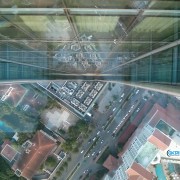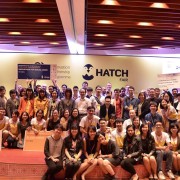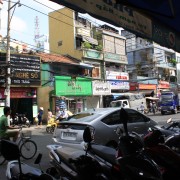Phonsavan, Xiengkhouang Province
Phonsavan is the capital of Xiengkhouang Province, arguably the most heavily bombed area of the most heavily bombed country (per capita), Laos, in the world. Phonsavan itself is a relatively new city—the old capital Muang Khoun, about 30 kilometers south of Phonsavan, was largely affected by the Second Indochina War (Vietnam War). In fact, the old capital was so damaged by the bombing that many of the original stupas were destroyed.
Besides these and other artifacts of war (e.g., a crumbling French hospital), the surrounding landscape here is quiet and peaceful; the sun pierces through limited cloud formations to form stunning arrays of light and long stretches of crisp blue sky seem to hang overhead indefinitely. At night stars and other space objects are clearly visible to the naked eye—a rare sight coming from hazy and smoggy Hanoi.
The main strip of Phonsavan has the distinct feel of an Old West town, especially with the backdrop of nearby rolling hills. At times, “Montana” comes to mind, however this thought is quickly squeezed out of mind when the surprising amount of Vietnamese and Chinese signage comes into focus. Throughout Phonsavan there is a healthy mix of Chinese and Vietnamese nationals; the Vietnamese influence is most visible in the form of late night pho restaurants and neon red lit massage parlors (tam quat) dotted on the main strip.
Passing through Phonsavan, it’s easy to spot the Vietnamese—they drive more erratically (locals here drive recklessly enough when compared to Vientiane drivers but Vietnamese-driven buses were described to us as “torpedoes”), speak more loudly, and have more aggressive demeanors (work ethic and attitude) than the laid-back Lao locals. Your author stopped by a banh mi shop on the side of the road and asked one Vietnamese man who had been in Phonsavan for five months what he thought of Lao people; he held out his right hand, rubbed his fingers together with his thumb, and quickly shook his head while grimacing. Nothing more needed to be said.
Interacting with Locals
At a local club called Dok Mai Daeng (“red flower” in Lao) young Hmong people dance in relentless synchronization which eventually morphs into equal parts mosh pit and dance battle as the music picks up in tempo and the MC directs their abundant energy from center stage. Young men lift each other up and attempt to publicly determine who between them is taller, pausing every so often to forcefully crash and jump into young women on the dance floor—who equally seem to enjoy the rough contact. In between songs, all parties return to their respective tables or the young men find suitable partners to dance slowly to, depending on the next song. Interesting as it may be, this excited and loud scene is a far cry from the typical expat experience in Phonsavan.
The consistent westerner expat community in Phonsavan is fairly small with a majority of backpackers and tourists rounding out the western presence; the latter mostly in town to check out the mysterious Plain of Jars or using the town as a rest stop on the way to Luang Prabang. The Plain of Jars (PDJ according to the French abbreviation) is the main tourist attraction nearby, with a different feel from backpacker tubing in Vang Vieng or high-end resort tourism in Luang Prabang. Most nights, longterm expats can be found at Bamboozle, a restaurant run by a Scot named Mark, and perhaps the best place in town to find a quality meal. These “local” expats are almost certainly working for an NGO or doing volunteer work in town related to the continued effects of the bombing campaigns from decades ago.
Mines Advisory Group (MAG) is out in the field on a daily basis and there are a number of other NGOs (such as UXO Lao) that focus on Unexploded Ordnance (UXO), ranging from clearance to victim support assistance. The UXO sector in Laos (“mine action” in the official parlance) comprises three areas: clearance, mine risk education, and victim assistance. These services are badly needed here because an estimated 30% of the more than 270 million cluster submunitions dropped on Laos failed to explode. To put that figure in perspective, an average of one sortie (a roundtrip flight by one aircraft) was conducted every eight minutes for nine years (1964-1973).
Besides UXO, the biggest enemy these days could be boredom in Phonsavan, which can lead to heavy drinking for locals and expats alike in this rural area. Drinking is part of daily life in Lao PDR, and in Phonsanvan the national past time doesn’t divert too far away from its core. Runway Club, the largest nightclub in the area (and nestled in a bus depot), serves as another collection point in the “night life” funnel for the locals. Post-curfew, anyone who is still in the mood to continue the night reunites at one of several late night Vietnamese restaurants, which can also house snooker tables. As in much of Asia, driving is a hazard, but in Phonsavan the activity takes a higher form of danger—especially with drunken drivers careening down the main strip late at night and others making impromptu U-turns without advance warning. It’s interesting to note that at every location we went to in Phonsavan, we were either the only westerners in a venue or we were surrounded by fellow westerners, a highly segregated experience.
A Mix of History, Cultures, and Futures
A local official whom we spoke to at “Beer Party” Restaurant in Phonsavan described Lao culture as the following :
1. Having enough rice to eat;
2. Having a house to live in;
3. Having friends and relatives to come over and drink with; and
4. Having a partner to share life with.
However, this official also spoke about the foreign exchange of technical skills with Lao people, i.e., needing advanced knowledge from other places. This official was the second person out of six or seven who proceeded to come to our table to introduce themselves to us and speak with us in a mix of Lao, English, and Vietnamese (in that order). One constant throughout the entire experience was the warmth and hospitable nature of the Lao people—always smiling, always greeting, and always trying to help foreigners adjust to the local settings.
Even when the subject turned to the Secret War, and the massive bombing campaign carried out by the US government during the 1960s and 1970s, our counterparts seemed apologetic when referencing what had partly transpired where we were standing over 30 years ago. On this subject, we had an experience which ended up being the most sobering of all during the time we spent at this local eatery: one man, a chemistry teacher at a local teacher’s college, explained to us that his father had been killed by the bombing. It wasn’t clear whether his father was a civilian, Pathet Lao, or Royalist supporter, but this man was still visibly affected by events leading up to the revolution in 1975.
Chinese and Vietnamese influence in Xiengkhoang Province during that time took on a different form but presently, the Chinese focus on the commercial development projects while the Vietnamese focus on residential construction; these activities give one the distinct feeling of the area being carved up for neighborly consumption (or competition, depending on perspective). One 27-year-old Chinese national whom we spoke to at Desa Restaurant had been in Lao PDR for about a year; he had learned the language by spending time working in the chemicals sector.
Almost as soon as we had sat down at our own table, we were quickly invited to his table where he had been drinking with three other similarly aged Lao colleagues. Together, we shared several rounds of Beerlao and exchanged questions and answers about our respective backgrounds; at one point, one of the Lao men expressed his desire to visit the US in the future while the others nodded in unison. Our other discussion topics ranged from marriage to work to travel plans. Toward the end of our night, we toasted our newfound friendships with each other: three Lao nationals, two Americans, and one Chinese citizen sitting together in a local hangout in one of the most heavily bombed areas in the world.




























